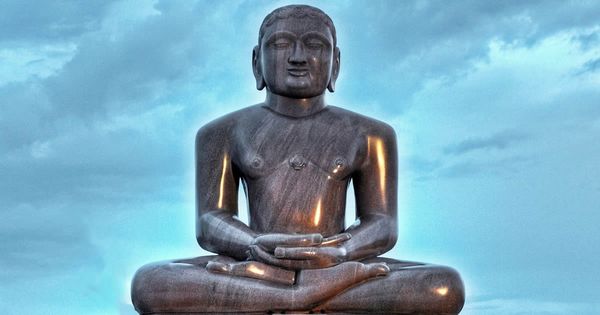Relevance for UPSC CSE
- UPSC Prelims - History of India (Ancient History)
- UPSC Mains - GS 1 (Indian culture - Religions in India)
Origin
- Jainism is one of the oldest ancient Indian religions. According to some traditions, it is believed that Jainism is as old as the Vedic religion
- Jainism came to prominence in the 6th century B.C., when Lord Mahavira propagated the religion.
- 24 Tirthankaras (Great teachers)
- 1st: Risabhdeva;
- 24th: Mahavira
- The word ‘Jain’ is derived from jina or jaina which means the ‘Conqueror’.
Spread of Jainism
Sangha: to spread Jainism
- both men and women
- consisted of both monks and lay followers
Reason for the Spread of Jainism?
- Mahavira organised an order of his followers which admitted both men and women.
- Jainism didn’t very clearly mark itself out from the brahmanical religion, therefore it spread gradually into West and South India where brahmanical order was weak.
- The great Mauryan King Chandragupta Maurya, during his last years, became a Jain ascetic and promoted Jainism in Karnataka.
- Famine in Magadha led to the spread of Jainism in South India.
- The famine lasted for 12 years, and in order to protect themselves many Jains went to South India under the leadership of Bhadrabahu.
- In Odisha, it enjoyed the patronage of Kalinga King of Kharavela.
Teachings
Triratnas
- Right Faith
- Right Knowledge
- Right Conduct (it refers to observance of five great vows)-
- Satya (truth)
- Ahinsa (not to injure life)
- Asteya (not to steal)
- Aparigrah (not to acquire property)
- Bramhcharya (not to lead immoral life)
Jain Doctrine
- Anekantavada: Emphasises that the ultimate truth and reality is complex, and has multiple-aspects i.e theory of plurality.
- Jainism recognized the existence of the gods but placed them lower than the Jina.
- They believe in God, not as a creator, but as a perfect being.
- All objects (animate and inanimate) posses soul
- Even agriculture was considered as sin
- Practice of asceticism and renunciation
- starvation, nudity, and other forms of self-torutre
- Sallekhana— Jain practice of taking voluntary death.
- Allowed only when the person is suffering from incurable disease or is at the end of his life
- Jainism believes in the transmigration of the soul and the theory of Karma
- Jainism did not condemn the varna system as Buddhism did
Seven Tattvas (elements) of Jain Philosophy
- Jiva (living substance)
- Ajiva (matter or non-living substance)
- Asrava (influx of Karmic matter in the soul)
- Bandha (bondage of soul by Karmic matter)
- Samvara (stopping of Asrava)
- Nirjara (gradual removal of Karmic matter)
- Moksha (attainment of perfect freedom or salvation).
Jain Councils
1st
- at Pataliputra by Sthulabahu
2nd
- at Valabhi
- Final compilation of Jain literature called Twelve Angas
Sects in Jainism
Svetambaras (white-clad)
- Propounded by Stulabadhra
- The Kalpasutra is a canonical text of the Svetambara
- written by Acharya Bhadrabahu in the 4th century BCE
- It is the biographical account of Mahavira and other Tirthankaras
Digambaras (Sky-clad or naked)
- It is more austere, and is closer in its ways to the Jains at the time of Mahavira
- They believe that Mahavira remained unmarried
- whereas the Svetambaras believe Mahavira married and a daughter was born to him
- Digambaras believe that women cannot achieve liberation without first being reborn as a man. This is because women cannot live a truly ascetic life, because they have to possess clothes since it is impractical for them to live naked.
- On the other hand Svetambaras believed that women may attain liberation and that Tirthankara Mallinath was female.
- Digambara monks do not wear clothes because they believe clothes , like other possessions, increase dependency and desire for material things.
- Svetambara monks, on the other hand, wear the white seamless clothes
- Suttapahuda text contains the earliest record of the beliefs of Digambaras
Differences between Buddhism and Jainism
Buddhism | Jainism |
Rebirth is one of the principal beliefs in Buddhism. It is thought that the endless cycle of birth and re-birth can only be broken by attaining Nirvana (Enlightenment) | Jainism believes that the circle of rebirths and deaths will continue due to good or bad deeds until liberation is achieved. (theory of karma) |
Scriptures include Tripitaka, which is a vast text consisting of 3 sections: the Discipline, the Discourse and the Commentaries. | Jain religious texts are called Agamas |
The principal teaching of Buddhism is that life is suffering and to escape suffering (end cause of desire) one needs to dispel ignorance by realizing the Four Noble Truths and practising the Eightfold Path | Jainism lays emphasis on the respect of all living beings. Liberation from the cycle of rebirths is attained by taking the Five Vows and following the principles of the Three Jewels |
Sin is not a concept in Buddhism | Sin is defined as harm to others |
Buddhism is divided into two major sects upon the death of Gautama Buddha. They are the Mahayana and the Theravada | Svetambara and Digambara are the two major sects of Jainism |
According to some texts in Buddhism, there are beings in heaven but they are bound by “samsara”. They suffer less but they have, not yet achieved salvation | Deities in Jainism are known as “Titrtheneakas”. But they are not worshipped in the conventional sense as they are regarded as wise teachers whose teachings must be followed |
Buddhism was founded in modern-day Nepal by Prince Siddhartha in the 6th century B.C | Scholars of religion generally hold that Jainism originated in the 7th–5th century BC in Northern India. Mahavira, also known as Vardhamana was the 24th Tirthankara (Spiritual Teacher) of Jainism |
Followers of Buddhism can be found mainly in Thailand, Cambodia, Sri Lanka, India, Nepal, Bhutan, Tibet, Japan, Myanmar (Burma), Laos, Vietnam, China, Mongolia, Korea, Singapore, Hong Kong and Taiwan | Followers of Jainism are found mainly in India, lower Asian subcontinent throughout, and America. Small groups exist in most countries |
Similarities between Buddhism and Jainism
Factors | Explanation |
Rejection of Vedas | Buddhism and Jainism rejected the notion of grand rituals along with the authority of the Vedas and the priestly class |
Animal Rights | Both Buddhism and Jainism also stressed the principle of non-violence against animals and they must also be given equal respect as one gives to a fellow human being |
Karma | Both Buddhism and Jainism believe in the concept of karma. Reincarnation carries this force forward and requires effort to purify the soul. |
God and Scripture | Neither religion believes in God as the creator of the universe. They acknowledge all creation as being part of the universe’s divinity. As such, their holy texts are not considered the word of a god or sacred stories. |
Reincarnation | Both believe in the concept of reincarnation. |
Read about Buddhism
Religions in India - Buddhism
Buddhism notes for UPSC Prelims and Mains

We are starting our Prelims 360 course on 16th Jan
It includes:
- GS 360 - Complete coverage cum revision of GS Prelims subjects
- CSAT 360 - Complete coverage cum revision of CSAT for Prelims
- Prelims Test Series - GS (16 tests ) + CSAT (5 tests)
- Current affairs coverage through weekly sessions
- One to one mentorship
- Weekly doubts day access!
- Daily Practice Questions (DPQs) based on the lecture taught.
Check out the course
UPSCprep Courses
Courses related to UPSC CSE Prelims, Mains and Optional. Study with past UPSC rankers as mentors. One stop for all your UPSC preparation needs.



